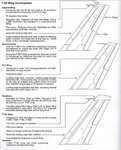GrauGeist
Generalfeldmarschall zur Luftschiff Abteilung
Why is this becoming so truncated?
What do you mean "fighter bomber" Are you referring to the Me262A-2/a?
The Meteor F.8 was nothing like it's WWII predecessor. Perhaps in appearance only, but it's airframe was enhances, it received a newer, more powerful engine and so on.
When the Meteor F.8 went head to head against the MiG-15, it was meeting it's peer in battle. Their performance was comparable (although the F.8 had better performance in some aspects) and they were both used as front line fighters. Therefore: Peer.
The Me262 would have been at home fighting any early jet types as they had similar or comparable profiles. But the core of the discussion was could the Me262 "dogfight" propellor types (although this was not it's mission).
The answer is no. And the pilots of the Me262, in their own words, said they would engage fighters only on their terms or else they would leave.
This would be like a P-51 trying to dogfight a Fokker D.VII - which it simply would not be able to do. The P-51 is much too fast to be able to get inside of the D.VII's turn (sound familiar?) so it's best option would be to zoom in on it and try and get in a burst before it turned away and got out of the gunsights.
In WWII, the F.3 of 616 squadron would have been the platform that the Me262 would have met historically had they ever caught sight of one another. They would have been able to get into a fight on equal terms much like the later Meteor types did against Soviet jets in Korea.
What do you mean "fighter bomber" Are you referring to the Me262A-2/a?
The Meteor F.8 was nothing like it's WWII predecessor. Perhaps in appearance only, but it's airframe was enhances, it received a newer, more powerful engine and so on.
When the Meteor F.8 went head to head against the MiG-15, it was meeting it's peer in battle. Their performance was comparable (although the F.8 had better performance in some aspects) and they were both used as front line fighters. Therefore: Peer.
The Me262 would have been at home fighting any early jet types as they had similar or comparable profiles. But the core of the discussion was could the Me262 "dogfight" propellor types (although this was not it's mission).
The answer is no. And the pilots of the Me262, in their own words, said they would engage fighters only on their terms or else they would leave.
This would be like a P-51 trying to dogfight a Fokker D.VII - which it simply would not be able to do. The P-51 is much too fast to be able to get inside of the D.VII's turn (sound familiar?) so it's best option would be to zoom in on it and try and get in a burst before it turned away and got out of the gunsights.
In WWII, the F.3 of 616 squadron would have been the platform that the Me262 would have met historically had they ever caught sight of one another. They would have been able to get into a fight on equal terms much like the later Meteor types did against Soviet jets in Korea.

